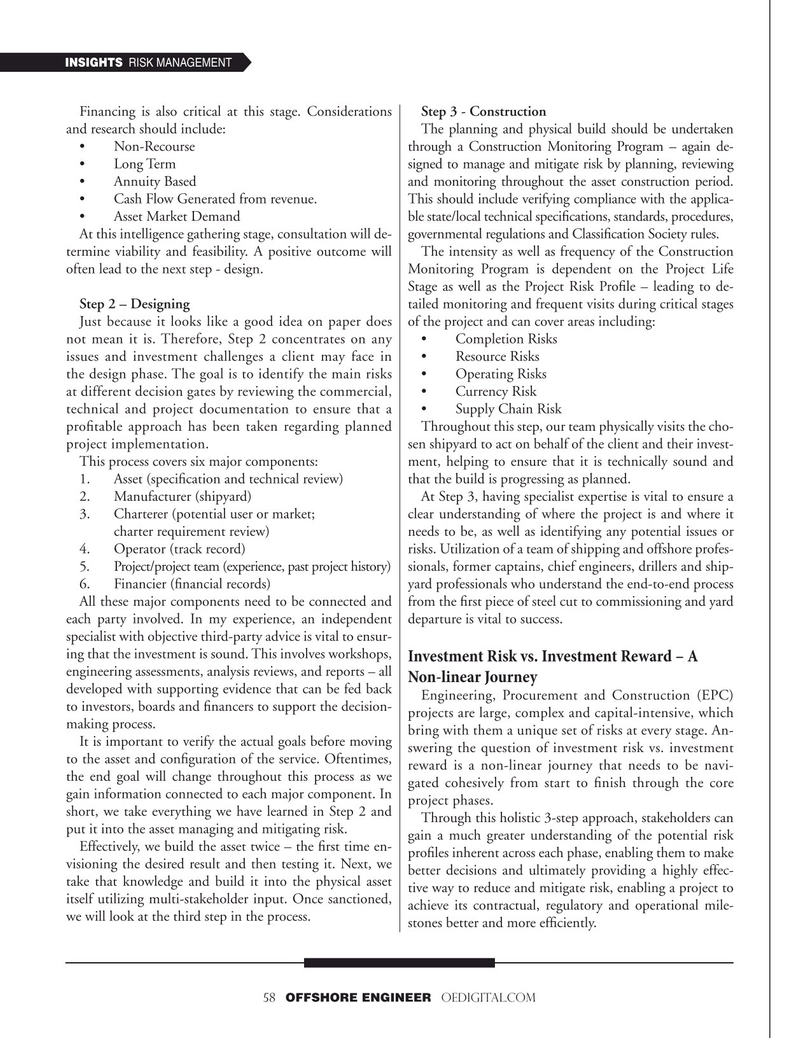
Page 58: of Offshore Engineer Magazine (Mar/Apr 2024)
Read this page in Pdf, Flash or Html5 edition of Mar/Apr 2024 Offshore Engineer Magazine
INSIGHTS RISK MANAGEMENT
Financing is also critical at this stage. Considerations Step 3 - Construction and research should include: The planning and physical build should be undertaken • Non-Recourse through a Construction Monitoring Program – again de- • Long Term signed to manage and mitigate risk by planning, reviewing • Annuity Based and monitoring throughout the asset construction period. • Cash Flow Generated from revenue. This should include verifying compliance with the applica- • Asset Market Demand ble state/local technical specifcations, standards, procedures,
At this intelligence gathering stage, consultation will de- governmental regulations and Classifcation Society rules.
termine viability and feasibility. A positive outcome will The intensity as well as frequency of the Construction often lead to the next step - design. Monitoring Program is dependent on the Project Life
Stage as well as the Project Risk Profle – leading to de-
Step 2 – Designing tailed monitoring and frequent visits during critical stages
Just because it looks like a good idea on paper does of the project and can cover areas including: not mean it is. Therefore, Step 2 concentrates on any • Completion Risks issues and investment challenges a client may face in • Resource Risks the design phase. The goal is to identify the main risks • Operating Risks at different decision gates by reviewing the commercial, • Currency Risk technical and project documentation to ensure that a • Supply Chain Risk proftable approach has been taken regarding planned Throughout this step, our team physically visits the cho- project implementation. sen shipyard to act on behalf of the client and their invest-
This process covers six major components: ment, helping to ensure that it is technically sound and 1. Asset (specifcation and technical review) that the build is progressing as planned.
2. Manufacturer (shipyard) At Step 3, having specialist expertise is vital to ensure a 3. Charterer (potential user or market; clear understanding of where the project is and where it charter requirement review) needs to be, as well as identifying any potential issues or 4. Operator (track record) risks. Utilization of a team of shipping and offshore profes- 5. Project/project team (experience, past project history) sionals, former captains, chief engineers, drillers and ship- 6. Financier (fnancial records) yard professionals who understand the end-to-end process
All these major components need to be connected and from the frst piece of steel cut to commissioning and yard each party involved. In my experience, an independent departure is vital to success.
specialist with objective third-party advice is vital to ensur- ing that the investment is sound. This involves workshops,
Investment Risk vs. Investment Reward – A engineering assessments, analysis reviews, and reports – all
Non-linear Journey developed with supporting evidence that can be fed back
Engineering, Procurement and Construction (EPC) to investors, boards and fnancers to support the decision- projects are large, complex and capital-intensive, which making process.
bring with them a unique set of risks at every stage. An-
It is important to verify the actual goals before moving swering the question of investment risk vs. investment to the asset and confguration of the service. Oftentimes, reward is a non-linear journey that needs to be navi- the end goal will change throughout this process as we gated cohesively from start to fnish through the core gain information connected to each major component. In project phases.
short, we take everything we have learned in Step 2 and
Through this holistic 3-step approach, stakeholders can put it into the asset managing and mitigating risk.
gain a much greater understanding of the potential risk
Effectively, we build the asset twice – the frst time en- profles inherent across each phase, enabling them to make visioning the desired result and then testing it. Next, we better decisions and ultimately providing a highly effec- take that knowledge and build it into the physical asset tive way to reduce and mitigate risk, enabling a project to itself utilizing multi-stakeholder input. Once sanctioned, achieve its contractual, regulatory and operational mile- we will look at the third step in the process.
stones better and more effciently.
58 OFFSHORE ENGINEER OEDIGITAL.COM

 57
57

 59
59